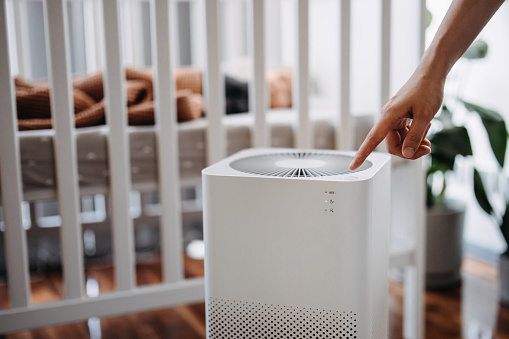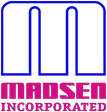
Take a deep breath. Isn’t it nice when the air you’re breathing in is fresh and clean? Well, it’s not only nice — it’s essential for our health. But it’s possible that the air inside your home that you’re breathing in everyday is actually dirtier than you realize. In fact, according to the EPA, the concentration of certain pollutants is usually 2-5x higher inside than outside.
But sometimes removing the source of the problem isn’t always possible (you’re probably pretty attached to your pup). So instead, you have to focus on removing all the bad stu from your air once it’s there. And that means having an air purifier.
Don’t worry, we’re experts in this kind of thing — which is why we’ve created this helpful guide to help you understand, choose, and get the most out of an air purifier that ensures only the highest quality air in your home.
What is an Air Purifier & Who Needs One?
An air purifier removes allergens that are floating through the air (because once they’re settled on the ground, it’s your vacuum’s time to shine). Air purifiers using HEPA filters — with a very fine mesh — are certified to collect 99.97% of “hard-to-capture” particles, or those <0.3 micrometers in size. This could include pet dander, dust mites, particulate matter from cigarette smoke or burning, or viral droplets.
There are two main ways to purify your air: room-by-room or whole-house.
Portable air purifiers are designed to filter the air within a single room and function completely separately from your home’s heating, ventilating, and air conditioning systems. It’s a supplemental unit, functioning like a space heater helping to cure a pesky draft, while a whole-house air purifier or filter is integrated into your house’s system. A portable purifier is the least effective way to clean your air but can be a helpful addition where you need it to be.
Types of Air Purifiers & Filters
There are a variety of air purifiers that use dierent types of technology to help clean the air in your home — some safer and more eective than others.
Ozone-Generating Air Cleaners
Ozone is a colorless gas in the atmosphere that protects us from harmful ultraviolet solar rays, but it can also react with certain pollutants to change their chemical composition — which can be dangerous to indoor air quality. Ozone-generating air cleaners actually produce ozone to create chemical interactions that are meant to alter the compounds of pollutants. And while manufacturers will claim they produce safe levels of this molecule, some generators will quickly exceed the FDA’s limit. Too much ozone in the air can worsen asthma, bronchitis, and more. All the while, lower levels of ozone have been proven to be ineective in destroying indoor pollutants.
Electronic Air Cleaners
Ionizers, electrostatic precipitators, hydroxyl generators, and UV light are all types of electronic air cleaners. They use electric voltage to convert oxygen molecules into charged ionic components that make airborne contaminants inactive. In this process, known as bipolar ionization (BPI), negative and positive ions surround the air particles to destroy germs and pathogens, while the added mass helps the particles fall to the floor versus circulating throughout the home.
However, BPI can omit some ozone and other free-radical species as a bi-product, while also being less eective than other techniques.
Filtering Air Cleaners
Air cleaners that use a filtering process sequester any particles or gasses as the air passes through a filter, returning only clean air through the other side. There are several debates about the extent of which these filters can handle removing
larger particles, such as pollen, mold spores, animal dander, etc. But most of these particles don’t stay suspended in the air for long anyway, landing on surfaces of the home and becoming the responsibility of other home cleaners.
There are two main types of filters:
- Mechanical Filter
These purifiers use fans to push air through a web of fine fibers that trap harmful particles, removing them from the air flow. They can remove both microscopic particles and larger particles when suspended in the air.
HEPA (high eciency particulate air) filters are a type of pleated mechanical filter with a very fine mesh. They are rated for containment ability of 0.3 μm particles — or the most challenging size to capture — which means their eciency of capturing other size particles is higher than 99.97%. That’s hard to beat.
- Carbon Filter
These filters are activated by carbon in the air to capture odor-causing gasses, but they’re not the best fight against formaldehyde, ammonia, or nitrogen oxide. Since these filters are limited in the variety of particles they can remove, they’re often paired with a mechanical filter. They also get saturated faster than mechanical filters, which means they need to be replaced more often.
What to Consider when Choosing an Air Purifier
1. Cost of Replacement Filters
In general, you should replace pleated filters every six to 12 months and activated carbon filters every three months. But the cost of filters vary greatly, from $20 to over $200 — so do your research as to not only what works the best, but also what works in your budget.
2. Clean Air Delivery Rate (CADR)
Every air cleaning unit has an air volume limitation which is identified by
CADR, measured in cubic feet per minute (CFM). It indicates how much filtered air a cleaner delivers per unit time across three separate scores: smoke, pollen, and dust — representing dierent particle sizes. The higher the number, the faster the unit is able to remove pollutants. So shoot for as high as possible!
3. Energy Star Certification
Since air purifiers run around the clock, energy cost is a factor you have to consider as well. If your air purifier has an Energy Star certification, it ensures 40% more energy eciency than standard models.
4. Room Size
Association of Home Appliance Manufacturers (AHAM) recommends that the CADR of your air cleaner is at least two-thirds of your room’s area. So if your room is 180 square feet, the CADR should be at least 120. If your ceilings are taller than 8 feet, this will aect the recommended rating as well.
5. Particle Size
If you’re a smoker or have pets, you’ll want to consider the air purifiers that can handle the smallest particles, such as HEPA filters. If you know you have VOCs, which can result from new furniture, consider a carbon filter, since it’s most eective for cleaning these types of gasses. If you notice an odor in your room, you’ll want to ensure you take the best course of action to eliminate and control the source itself, and Madsen can help you develop a plan to do so. Contact us for an air filtration assessment today, and we’ll get to the bottom of it.
6. Noise
While performance is going to be your top determinate, noise should be a close second. Because having clean air shouldn’t come at the cost of your sanity. These machines will run constantly, so you want them to be quiet. Look for units that have around 50 decibels, which is equivalent to the sound of a typical refrigerator. This decibel level should be written on the model’s packaging or website.
Tips to Get the Most Out of Your Purifier
Once you’ve chosen the right purifier(s) for your home, there are also ways you can ensure it’s running eciently and performing at its very best.
- Clean or replace the filters regularly. A dirty filter isn’t going to help your purifier do its job. Remember, a good rule of thumb for replacement or cleaning (if yours are reusable) is six to 12 months, and every three months for carbon filters. Most filters will have an indicator light to help you know when it’s time.
- Be smart about placement. Even portable units can be dicult to move around, so if you only have one unit, make sure it’s being used wisely. Place it in the room you spend the most time (and breathe in the most air). Also make sure it’s in a spot where nothing is obstructing the airflow — like curtains or furniture — so you know it’s able to do its job.
- Adjust the speed. Similar to your thermostat, you can adjust your unit’s speed based on when you’re actually in the room. But in this case, due to the noise these units can make, you may want to turn it to its highest setting when you’re not in the room and lower it when you are. You can also buy an air purifier certified for a larger area and run it at a lower speed to be efective.
If you’d like to have a professional come assess your home’s air quality and make recommendations for your unique needs, or you’re simply looking for other ways to improve your air quality, contact Madsen today. Our experts are happy to help you make the best decision for your home or workplace.


